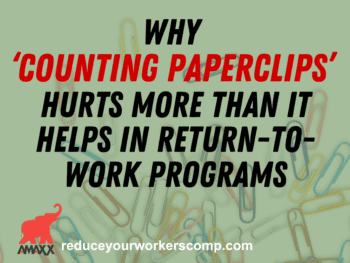
Benefits of Return to Work
Transitional work programs have the advantage of allowing injured employees to regard themselves as “actively employed” and thus productive and valuable members of the workforce. These programs are also financially beneficial for the company because keeping the employee at work helps the employer realizes significant workers’ compensation cost reductions.
In addition to reducing workers’ compensation costs, transitional work programs also help decrease short- and long-term disability insurance or wage continuation costs for non-occupational injuries. While employees in a transitional work program assignment may be less than 100 percent productive, having an injured employee working part-time in a limited capacity is more cost-effective than having one who does not work at all.
Click Link to Access Free PDF Download
“13 Research Studies to Prove Value of Return-to-Work Program & Gain Stakeholder Buy-In”
Many companies, however, are reluctant to initiate transitional work programs. Some employers believe worker unions will not accept these programs, or the programs themselves will not be time- or cost-effective. However, evidence proves transitional work programs are very cost-effective, and a well-managed transitional work program can result in a return-to-work rate of up to 90 percent for injured employees returning to the job within four days after the injury. These significantly shortened workers’ compensation claims result in lowered indemnity costs and overall improvement in the company’s workers’ compensation loss experiences.
Reluctant employer concerns suggest the primary barriers to setting up transitional work programs are related to attitude toward return to work. Therefore, successful implementation of return to work programs requires risk managers to convince their companies, employees, and treating physicians that transitional work programs are beneficial for all concerned.
FREE DOWNLOAD: “13 Research Studies to Prove Value of Return-to-Work Program & Gain Stakeholder Buy-In”
Convincing Employers
To convince employers of the benefits of transitional work programs, risk managers should point out the key factors supporting their use. First, the risk manager can demonstrate how the company will realize significant financial savings if a return-to-work program is established. An employer can expect an average of 30 percent in savings for workers’ compensation costs for a well-managed return-to-work program.
To illustrate, consider this example. Suppose for every day an employee is brought back to work in a transitional duty capacity, a company realizes savings of $100 per day. If the employer has 50 workers on lost-time status who return to work in a transitional job assignment capacity one day earlier, the employer would realize savings of $5,000 per day. At a 5 percent profit margin, the return-to-work program would save the company $100,000. In other words, it would “cost” the company $100,000 to replace the $5,000 on the company’s bottom line (if the firm has a 5 percent profit margin.)
The risk manager can also point out how transitional work jobs can be as diverse and creative as the employer chooses. For example, employers can establish transitional work programs by gathering work “wish lists” from their managers. These lists could consist of the “to-do” tasks managers would like to accomplish but cannot due to time constraints and other more demanding work priorities. Perhaps one department needs inventory taken, another department requires updates to their database, or possibly someone to pay more attention to their social media presence.
Companies can have recuperating employees perform these tasks, thus helping to boost productivity. Companies should also attempt to make transitional work positions creative and productive. For example, by drawing from the “wish list,” employers can develop varied activities, thus keeping a recuperating employee gainfully occupied.

Michael Stack, CEO of Amaxx LLC, is an expert in workers’ compensation cost containment system and provides education, training, and consulting to help employers reduce their workers’ compensation costs by 20% to 50%. He is co-author of the #1 selling comprehensive training guide “Your Ultimate Guide to Mastering Workers’ Comp Costs: Reduce Costs 20% to 50%.” Stack is the creator of Injury Management Results (IMR) software and founder of Amaxx Workers’ Comp Training Center. WC Mastery Training teaches injury management best practices such as return to work, communication, claims best practices, medical management, and working with vendors. IMR software simplifies the implementation of these best practices for employers and ties results to a Critical Metrics Dashboard.
Contact: mstack@reduceyourworkerscomp.com.
Workers’ Comp Roundup Blog: http://blog.reduceyourworkerscomp.com/
©2023 Amaxx LLC. All rights reserved under International Copyright Law.
Do not use this information without independent verification. All state laws vary. You should consult with your insurance broker, attorney, or qualified professional.
















